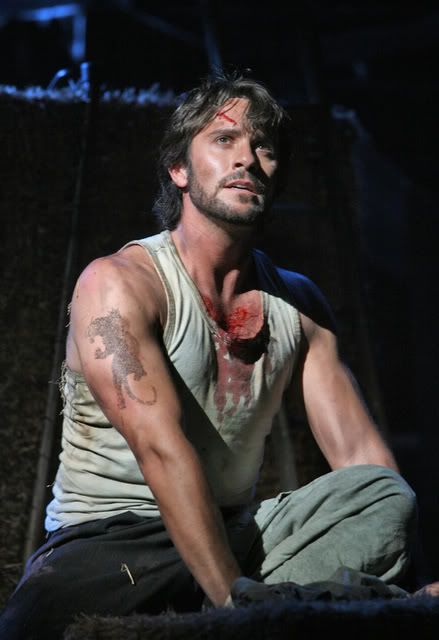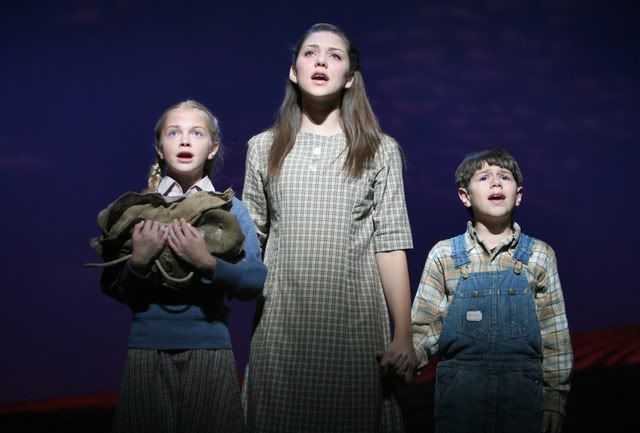
The cast of the North American tour of Jesus Christ Superstar (featuring Aaron LaVigne in the center as the title character) has a light last supper. The show is at the Golden Gate Theatre as part of the BroadwaySF season. Below: James T. Justis is Judas. Photos by Matthew Murphy
Hosanna, hey sanna, sanna sanna ho! It sure feels good to be back in a big theater seeing a big Broadway show. This must be the way some people feel going back to church. You might even call it a religious experience.
Except when the show in question is Jesus Christ Superstar, that spiritual uplift quickly turns into confusion. With only a limited knowledge of the Bible, I’ve always found JCS to be a mediocre show with occasional thrills in the score by Andrew Lloyd Webber and Tim Rice. I can fully understand why this show became such a sensation more than 50 years ago when the concept album was released (and nothing fires sales more than cries of “Sacrilege!”). Here was a rock opera/Passion Play that really rocked and yowled like the music of the day but also had some orchestral heft to differentiate it from other emerging rock musicals (like Hair).
I can also understand how audiences might have been baffled when the show opened on Broadway Oct. 12, 1971 (50 years ago this week!). If you don’t already know the story of Jesus’ last few weeks or who Judas or King Herod were, the show doesn’t do much to help you out.
Over the last five decades, JCS has become a mainstay, and it seems revisions and revivals and re-imaginings have kept this show resurrecting nonstop. I have yet to see anyone make a case for this being a great show, and the 50th anniversary North American tour now at the Golden Gate Theatre as part of the BroadwaySF season is more interesting than many productions I’ve seen, but it still falls significantly short of miraculous.
Director Timothy Sheader, who first staged this production for London’s Regent’s Park Open Air Theatre in 2016, aims to rediscover the zeal and youthful cheekiness of the original two-disc concept album by training focus on the music and making this show feel more like a concert than a traditional musical. And the music (not necessarily the voices) quickly emerges as the best part of this touring production. Music director Shawn Gough leads an 11-piece ensemble that expertly captures that unique Lloyd Webber sound blending the symphonic with rock, most notable here in the horns and the guitars.
Set on what looks to be the naked girders of a ruined building (set design by Tom Scutt, who also designed the hair and the costumes), the band occupies the upper levels while the ensemble scampers all over the stage, with a lot of concentrated action on the cross-shaped platform.
Actors in this show don’t have a lot to work with when it comes to characters. They get one act and 95 minutes of nearly nonstop singing that fails to provide much in the way clarity or emotional connection. Aaron LaVigne only really makes an impression as Jesus during “Gethsemane.” Otherwise he just seems like a nice, man-bunned hipster who gets caught in a violent sci-fi story with a mean friend (James T. Justis as Judas) and a sex worker friend who doesn’t know how to love him (Jenna Rubaii as Mary Magdalene). Pilate and the Roman soldiers look like murderous aliens, and King Herod (a fun Paul Louis Lessard) seems to be visiting from an entirely different, much campier and more enjoyable planet.
There’s a weird blend of the realistic and the mythical here. For instance, when Jesus is arrested and is heading toward execution, he emerges shirtless and drenched in blood. Then, when it’s time for the 39 lashes, the whip is replaced with golden glitter bombs. By the end of the lashing, he looks like a terribly abused Academy Award crossed with a disco ball. Probably not the vibe you want when you’re about to watch someone die slowly on a cross.
The thing about Jesus Christ Superstar is this: if you get carried away by the original album (and it still sounds remarkably vital), there is likely never going to be a production better than the one in your head. But isn’t it interesting that the theater where JCS premiered 50 years ago, the Mark Hellinger Theatre, is now the Times Square Church? Hosanna indeed.
FOR MORE INFORMATION
Jesus Christ Superstar continues through Nov. 7 as part of the BroadwaySF season at the Golden Gate Theatre, 1 Taylor St., San Francisco. Tickets are $56-$226. Call 888-746-1799 or visit broadwaysf.com
BroadwaySF COVID policies are here.



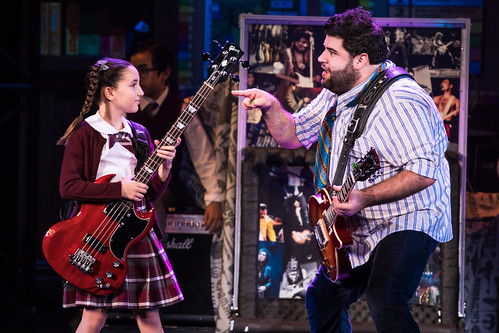
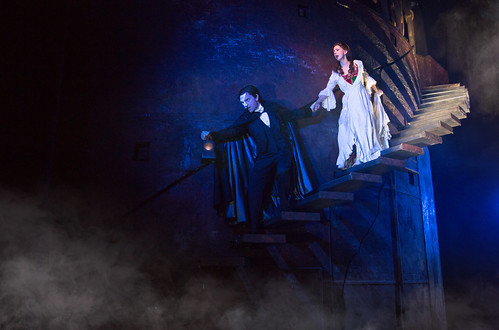
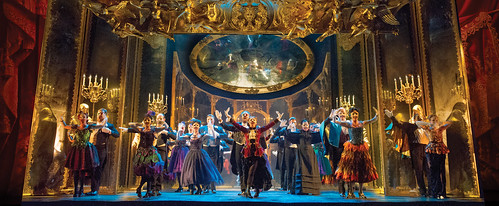

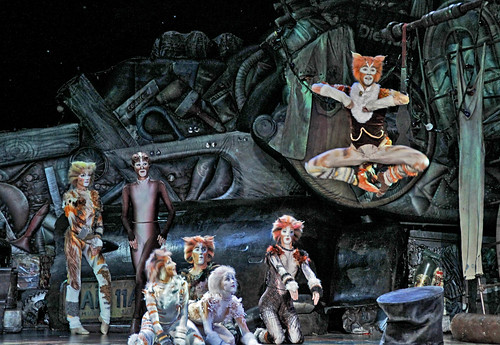
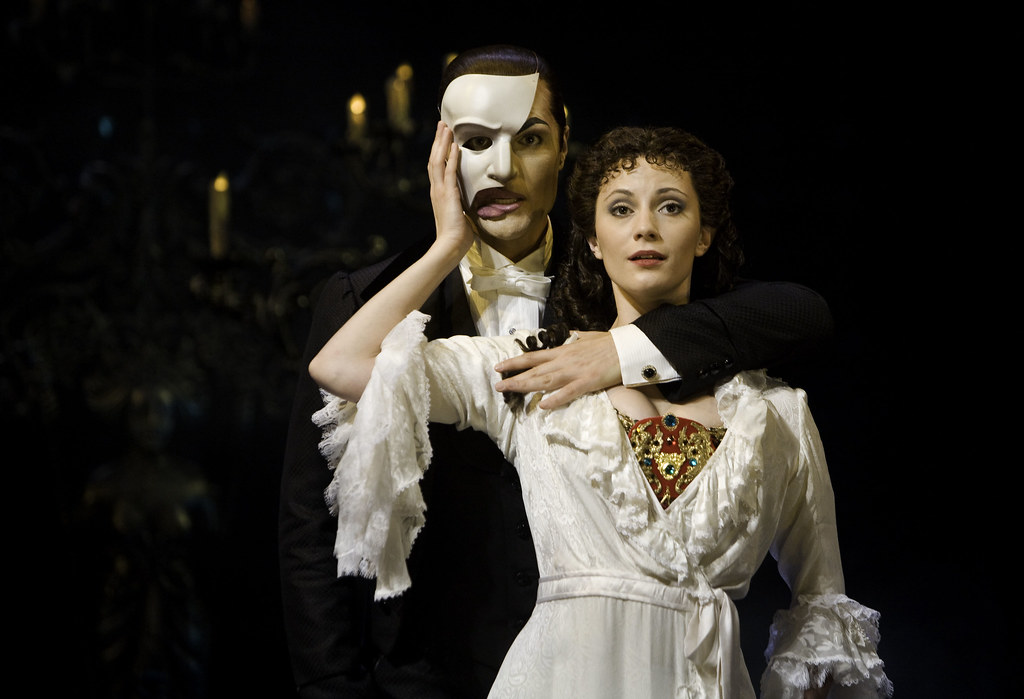
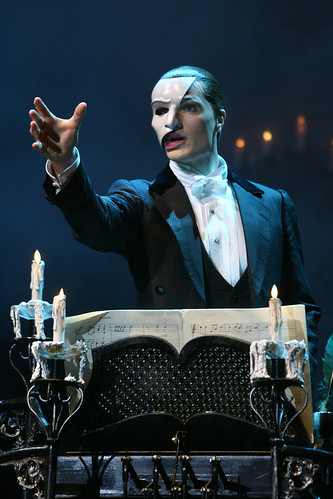 This tour, which runs through the holidays, is lucky to have two solid, reliable leads. John Cudia (at right, photo by Cylla van Tiederman) has one of the nicest Phantom voices I’ve heard – it’s warm, powerful and lacks the quirky strain of Crawford and longtime San Francisco Phantom Franc D’Ambrosio. And Trista Moldovan as Christine possesses a voice as lovely as she is. Both Cudia and Moldovan act and strike poses in the purple style required by this bosom-heaving gothic romance, but they exercise restraint in a way few of their cohorts manage to do. And they sound glorious.
This tour, which runs through the holidays, is lucky to have two solid, reliable leads. John Cudia (at right, photo by Cylla van Tiederman) has one of the nicest Phantom voices I’ve heard – it’s warm, powerful and lacks the quirky strain of Crawford and longtime San Francisco Phantom Franc D’Ambrosio. And Trista Moldovan as Christine possesses a voice as lovely as she is. Both Cudia and Moldovan act and strike poses in the purple style required by this bosom-heaving gothic romance, but they exercise restraint in a way few of their cohorts manage to do. And they sound glorious.

 In March of 2009, Grease is the word. This is the production directed and choreographed by Kathleen Marshall that got famous for being the first Broadway musical to cast its leads on national television (through the NBC show “Grease: You’re the One That I Want.” This is also the production that marries the original stage version with the movie version, so songs such as “Hopelessly Devoted to You” and “You’re the One That I Want” are included.
In March of 2009, Grease is the word. This is the production directed and choreographed by Kathleen Marshall that got famous for being the first Broadway musical to cast its leads on national television (through the NBC show “Grease: You’re the One That I Want.” This is also the production that marries the original stage version with the movie version, so songs such as “Hopelessly Devoted to You” and “You’re the One That I Want” are included.

 1. Jason Castro (right), whose inability to speak in sentences or use actual words during the brief interview segment makes me think he’s not much brighter than his dreadlocks. Who else but a dim bulb would choose to sing “Memory” from Cats, probably the most popular, most over-sung show tune of the last 25 years? He didn’t have the voice for it, he didn’t make a dramatic connection, and he didn’t make an original arrangement (the way Israel Kamakawiwoʻole did with “Over the Rainbow” and which Castro cribbed in its entirety a few weeks back) that was more suited to his laidback style.
1. Jason Castro (right), whose inability to speak in sentences or use actual words during the brief interview segment makes me think he’s not much brighter than his dreadlocks. Who else but a dim bulb would choose to sing “Memory” from Cats, probably the most popular, most over-sung show tune of the last 25 years? He didn’t have the voice for it, he didn’t make a dramatic connection, and he didn’t make an original arrangement (the way Israel Kamakawiwoʻole did with “Over the Rainbow” and which Castro cribbed in its entirety a few weeks back) that was more suited to his laidback style.
 There was a lot of talk about how difficult it would be for the Idols to perform show tunes because show tunes are so complicated, and judge Simon Cowell (left with Sir Andrew) has already shown his disdain for the “Broadway” sound (which he lumps in with the sound of cruise ships, cabaret and theme parks). But Lloyd Webber isn’t complicated. He has melodies, that’s for sure. But wouldn’t it be interesting to see what the Idols would do with the songs of Stephen Sondheim? Or Michael John La Chiusa? Or Jason Robert Brown? Or Ricky Ian Gordon? Or Adam Guettel?
There was a lot of talk about how difficult it would be for the Idols to perform show tunes because show tunes are so complicated, and judge Simon Cowell (left with Sir Andrew) has already shown his disdain for the “Broadway” sound (which he lumps in with the sound of cruise ships, cabaret and theme parks). But Lloyd Webber isn’t complicated. He has melodies, that’s for sure. But wouldn’t it be interesting to see what the Idols would do with the songs of Stephen Sondheim? Or Michael John La Chiusa? Or Jason Robert Brown? Or Ricky Ian Gordon? Or Adam Guettel? 

